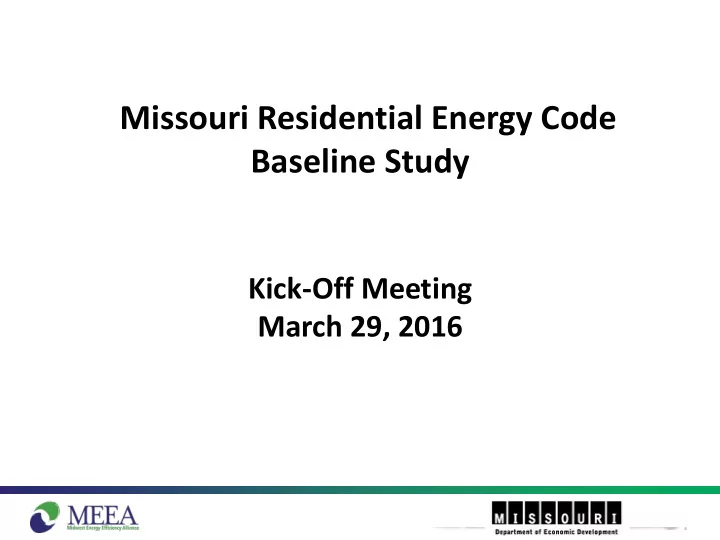

Missouri Residential Energy Code Baseline Study Kick-Off Meeting March 29, 2016
Presentation Topics • Overview of Project and Meeting Goals • Rationale and Goals of Study • Study Structure, Partners, & Process • Data Analysis • Results from Previous Study (Kentucky) • Sampling Plan • Group Discussion 2
Meeting Goals • Inform key energy code stakeholders of the study and data collection plan • Get stakeholder input on Assessment Methodology and Sampling Plan • Facilitate an efficient data collection process through stakeholder collaboration 3
Overview of Project • ARRA: 90% compliance with 2009 IECC by 2017 • DED/DE contracted with MEEA to conduct residential study to determine current construction practices relative to 2009 IECC • Results from this study will be used to determine statewide compliance with ARRA requirements • New single-family homes throughout Missouri 4
Goals & Rationale of Study • Collect in-field construction data from random sample of homes across Missouri • Obtain statistically-significant observations of 9 key measures • All data collected will be anonymous and only analyzed on statewide level • Use collected data as a basis to determine statewide compliance with ARRA requirements 5
9 Key Items • Envelope Tightness • Window Solar Heat (ACH50) Gain Coefficient (SHGC) • Window U-Factor • Exterior Wall • Ceiling Insulation Insulation • Foundation Insulation • High Efficacy Lighting • HVAC Right Sizing • Duct Leakage (Manual J Block Load) 6
Study Structure and Timeline • DED/DE: Funding and general oversight of study • MEEA: Management of study & subcontractors • Matt Belcher: Outreach to builders & code officials and coordinating site access • The Cadmus Group: On-site data collection Data collection begins April 6 th and ends June 30 th . 7
Matt Belcher (Data Collection Facilitator) 8
Data Collection Facilitator • Calls permitting jurisdictions for recent permitting information • Permits are randomized • Calls builders in order from randomized list – Tells them about study – Requests permission to come on site • Passes builder contact info onto Data Collector after receiving “yes” response 9
The Cadmus Group (Data Collector) 10
Data Collector Process • After Matt calls builder and receives a “yes,” Cadmus will call to schedule the site visits – Idaho area code • Minimal Disruption to operations • Experience in other states • 15 homes / week • Submitting anonymous data collection sheets to MEEA 11
Analysis Methodology 12
Analysis Methodology • Establish range & frequency of observations for each key item • Identify observations that don’t meet minimum code requirement – Only analyzing non-compliant items that are 15%+ of observations • Run EnergyPlus models for these items to establish energy use (all other items kept at code level) • Compare non-compliant energy usage to compliant energy usage to establish savings 13
Overview of Kentucky Results • MEEA and Cadmus conducted similar baseline study in Kentucky as part of larger effort, funded by DOE – 8 states are participating – Baseline Study, Training & Education, Post-Study • Find out more at http://1.usa.gov/1LU3qQ5 14
Wall Insulation R-Value: Kentucky 60 53 50 Orange Line = Code Requirement (R-13 40 Frequency minimum) 30 20 11 10 5 3 1 1 0 11 12 13 14 15 16 17 18 19 20 21 R-Value
Wall Insulation Quality: Kentucky 50 43 45 40 1 is the highest insulation 35 quality, and 3 is the lowest Frequency insulation quality 30 24 25 20 15 10 4 5 0 1 2 3 Insulation Quality 16
High Efficacy Lighting (%): Kentucky 40 36 35 30 Orange Line = Code Requirement (50% minimum) 25 Frequency 20 15 9 10 5 5 5 3 2 2 2 2 1 0 0 10 20 30 40 50 60 70 80 90 100 Percentage 17
Blower Door Results (ACH50): Kentucky 12 11 Orange Line = Code 10 Requirement (7 ACH50 maximum) 8 8 8 Frequency 7 6 6 6 5 4 4 2 2 1 1 1 1 1 1 0 1 2 3 4 5 6 7 8 9 10 11 12 13 14 15 16 17 18 19 20 ACH50 18
Duct Leakage - Unconditioned Space (CFM25): Kentucky 10 9 9 Orange Line = Code 8 Requirement (12 CFM25 maximum) 7 Frequency 6 5 5 5 5 4 4 3 3 3 2 2 2 1 1 1 1 1 1 0 1 2 3 4 5 6 7 8 9 10 11 12 13 14 15 16 17 18 19 20 21 CFM25 19
Kentucky: PNNL - Statewide Measure by Measure Energy Savings Total Total Total Total Total Natural Total Electricity Energy Natural Energy Measure Gas Electricity Savings Savings Gas Cost Savings Savings (kWh) (MMBtu) Savings Savings (therms) Wall - PNNL 1,199,555 51,841 9,277 $117,436 $53,608 $171,044 Lighting - 2,206,514 (17,865) 5,742 $216,018 ($18,473) $197,544 PNNL ACH 50 - PNNL 3,245,622 161,079 27,182 $317,746 $166,568 $484,314 Duct Leakage 444,934 13,060 2,824 $43,559 $13,505 $57,064 - PNNL $909,966 7,096,625 208,115 45,025 $694,759 $215,208 TOTAL 20
Enjoy The Break! 21
Sampling Plan Methodology • Based on 2015 Census Permit Data • Only Single Family Homes • Permits are Weighted by County • Then Randomly Selected • Representative Cross-Section of Construction 22
23
Group Discussion • Feedback on sampling plan • Suggestions of partners/contacts to make data collection as efficient as possible • General discussion, feedback, and questions 24
Next Steps • Field data collection begins April 6 th in St. Louis area • Matt has begun calling jurisdictions & will continue • MEEA will organize a mid-point stakeholder update meeting in May – Final stakeholder meeting will take place this summer once results are in 25
Contact Information • Chris Burgess, MEEA – cburgess@mwalliance.org • Kelsey Horton, MEEA – khorton@mwalliance.org • Matt Belcher – belcherma@missouri.edu • Brenda Wilbers – brenda.wilbers@ded.mo.gov 26
Recommend
More recommend